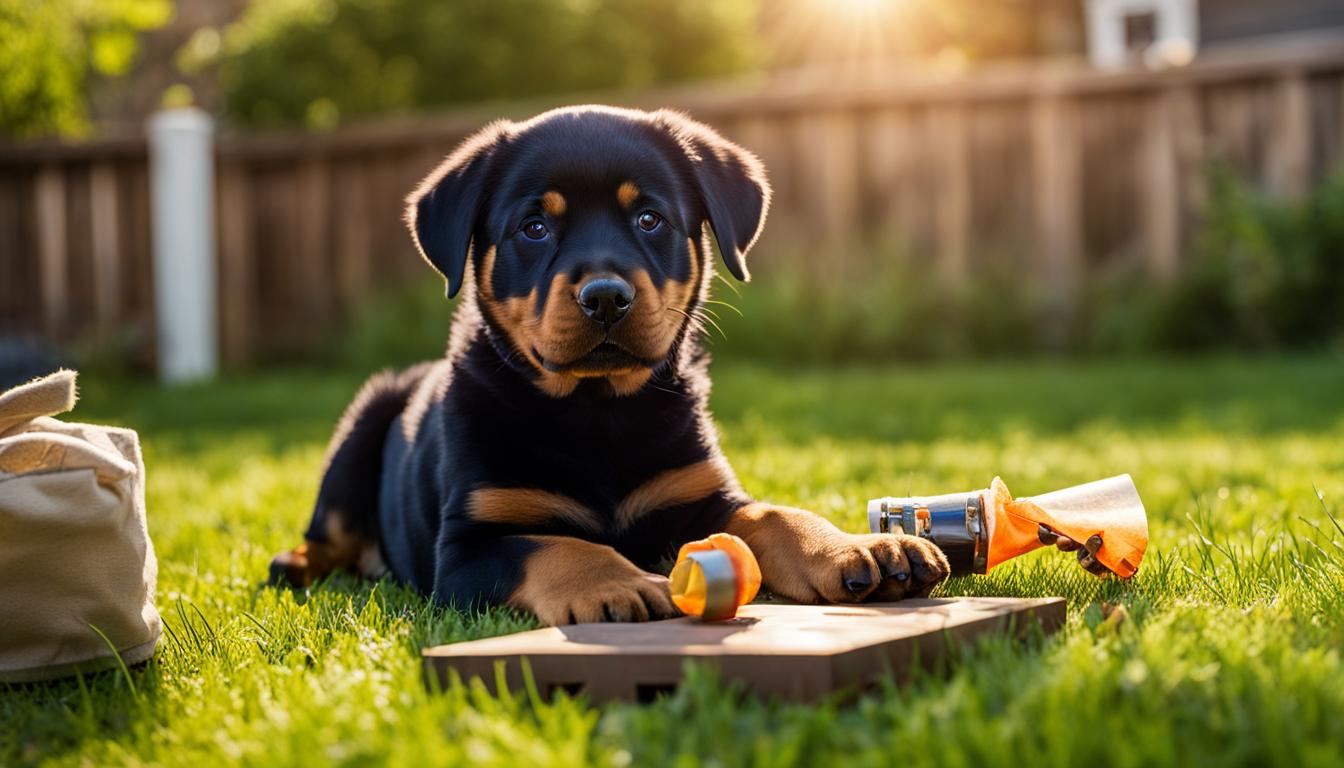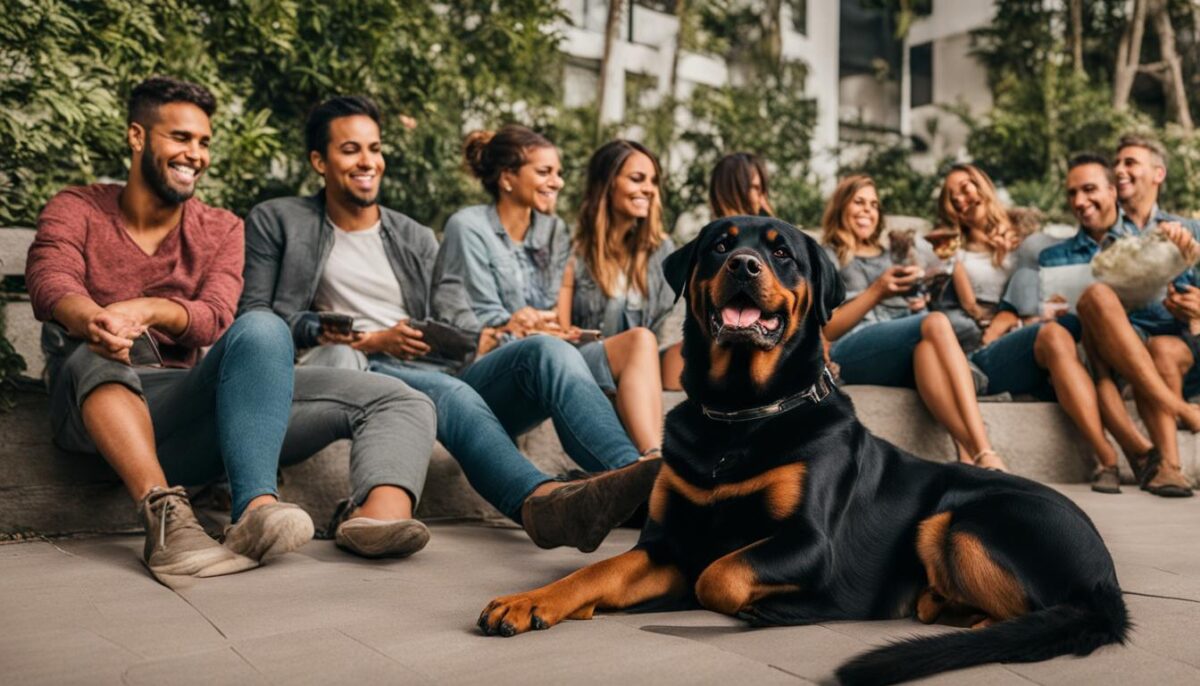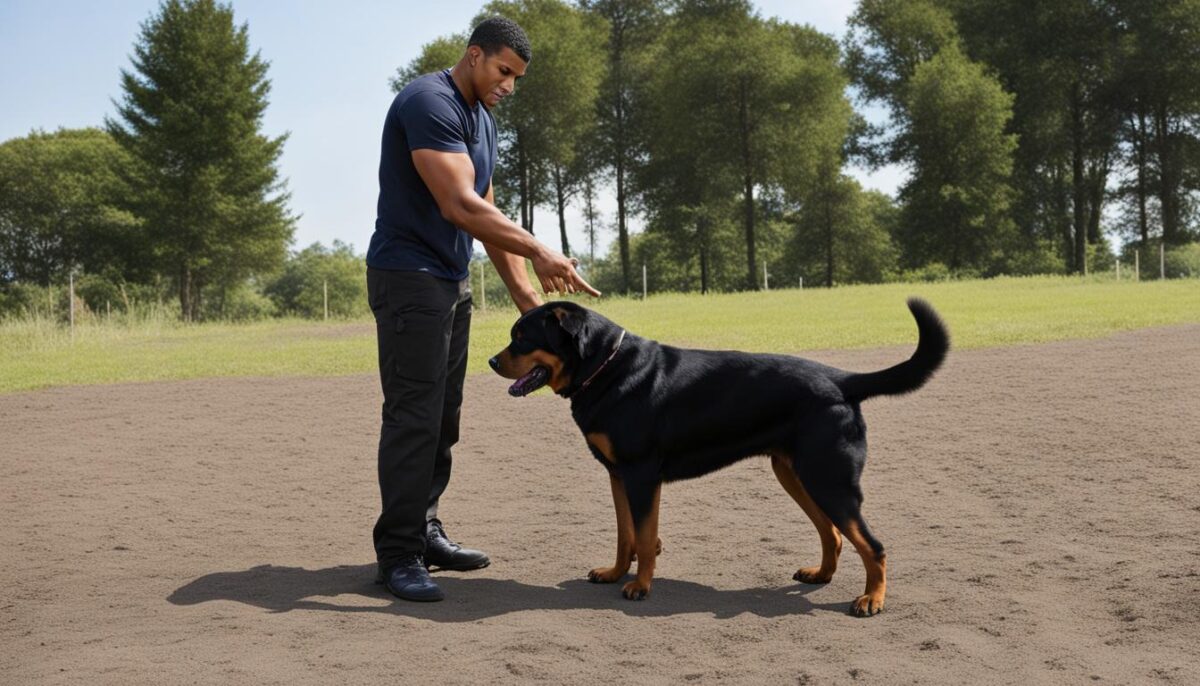Are you excited to bring a new Rottweiler puppy home? Or maybe you already have a Rottweiler and want to train them better. That’s great! Rottweilers are smart and strong buddies. They can learn many things if you teach them in a fun and kind way. When you train your Rottweiler, use lots of love and treats. This makes learning easier for them and they listen well. Remember, the secret to good dog obedience is to keep practicing the things they learn. It’s not just for when they are little, but for their whole life. Let’s help your Rottweiler know how to be a good dog with you!
You might be a bit worried, thinking, “How can I train my Rottweiler the right way?” Don’t worry! We will use **positive reinforcement** together. This means giving your Rottweiler a pat or a treat when they do something good. If you start Rottweiler puppy training early, you will see how they love making you happy. So, let’s start training together and have fun!
Key Takeaways
- Start training your Rottweiler while they are still a puppy for the best results.
- Use lots of love and treats to train your Rottweiler—it’s more fun for them.
- Keep training your Rottweiler even when they learn new things.
- Dogs, like your Rottweiler, are smart and become good friends when trained well.
- Remember that **positive reinforcement** is the best way to help your Rottweiler learn.
Understanding Your Rottweiler’s Nature
Knowing about your Rottweiler’s behavior is key to a happy life together. These friendly pups are smart and they love to show loyalty. The way you train your Rottweiler from the start can make a big difference in how they act. Let’s learn how to help your Rottweiler become the best dog they can be.
The Importance of Starting Training Early
Did you know that teaching your Rottweiler when they are just a little puppy is super important? Early dog training, starting from 6 weeks to 6 months old, helps your pup understand what you want from them. It keeps them from picking up bad habits, and it’s easier than starting when they’re older. If your Rottweiler is not a puppy anymore, that’s okay too! You can still teach an old dog new tricks with some extra patience.
Recognizing Your Rottweiler’s Intelligence and Loyalty
Rottweilers are smarter than you might think! They can learn many things and are known for their dog intelligence, so teaching them tricks and good behavior can be fun. With their loyalty, they really like making you happy. When you teach your Rottweiler with kindness, they learn better and become a super loyal furry friend.
Dispelling Myths About Dominance Training
Some people used to think that being the boss in a tough way was the best to train dogs. But now we know that’s not true, especially for Rottweilers. It’s an old idea called dominance-based training, and it’s not kind or helpful. Focusing on being kind and understanding your Rottweiler is the best way to teach them. Let’s use love instead of saying we need to be the alpha dog.
| Dog Training Approach | Early Training (6 weeks to 6 months) | Adult Training |
|---|---|---|
| Positive Play and Rewards | Teach simple games and give treats for good behavior. | Use favorite toys and longer playtime to teach new tricks. |
| Teaching Commands | Start with sit, stay, and come—easy commands to learn. | Keep practicing commands they know, add new ones. |
| Understanding and Patience | Give lots of love and cuddles, be patient with mistakes. | Be a calm and steady friend, even when correcting them. |
So, remember to start training your Rottweiler early, appreciate their smart minds, and stick to kind and loyal ways of teaching. This will help your Rottweiler learn and grow in the happiest way possible. Ready for more fun with your Rottweiler pal?
The Foundation of Socialization
Building Rottweiler social skills is like raising a friendly kid. It’s all about letting your Rottweiler meet new friends and learn how to play nice. When you expose your Rottweiler to social experiences, it’s like taking them to the best parties where everyone wants to pet and praise them. This is how they learn to be cool dogs in any situation. It’s all part of dog socialization, where your furry buddy gets to sniff around and discover that the world is a pretty fun place to explore.
Remember, every time they meet someone new or sniff a different dog, they are learning. It helps them to not be scared or mean when they bump into other dogs at the park. But if they see something that makes them unhappy, they might remember it and be scared next time.
So, how do you do it? Take them for walks. Visit your friends who have nice dogs, and let your pup say hello. Have people over and show your Rottweiler that guests are awesome. Teach them easy things like ‘sit’ or ‘stay’ so they know how to chill out when there’s a lot going on. It’s all about the good vibes. Make every new hello a happy one!
| Social Experience | Why It’s Good |
|---|---|
| Walking in the Park | They learn to walk by your side even when there are distractions. |
| Visiting Friends | Your Rottweiler learns that new people and pets are friends, not foes. |
| Having Guests Over | They get practice being calm and friendly in their own home. |
| Playdates with Other Dogs | They learn to share their toys and play without getting too rough. |
So don’t forget, the more fun and friendly meetups your Rottweiler has, the happier and nicer they’ll grow up to be. It’s all about making sure they know that the world is full of friends!
Positive Reinforcement: The Key to Obedience
When you teach your Rottweiler new tricks, using positive reinforcement training is like giving them a high five. It’s a way to say, “Great job!” to your furry friend. Imagine how happy you feel when someone gives you a sticker for a job well done. That’s how your dog feels getting dog rewards.
Choosing the Right Rewards for Your Rottweiler
The best reward for your Rottweiler can be a tasty treat, a fun toy, or even a cheerful “Good dog!” Let’s find out which rewards make your Rottweiler’s tail wag the most! It’s all about keeping your Rottweiler’s health in mind, so choose healthy snacks and safe toys.
Turning Training Into a Rewarding Game
Learning can be just like playing. When you turn obedience training into a fun game, your Rottweiler will listen and learn better. Throw a frisbee and ask them to bring it back or hide treats and watch your buddy sniff them out. It’s like the floor is lava, but for dogs!
Managing Treats to Avoid Weight Issues
Just like us, Rottweilers should not eat too many treats to stay in good shape. It’s important to keep an eye on how many treats they munch on to protect their Rottweiler health. Let’s see how you can keep track of those treats.
| Activity | Yummy Reward | Health Tip |
|---|---|---|
| Learning ‘Sit’ | Small piece of chicken | Keep it lean, no skin |
| Playing Fetch | Carrot sticks | Crunchy and low-cal |
| Practicing ‘Stay’ | Homemade dog biscuit | Watch the portion size |
How to Train a Rottweiler Dog
Training your Rottweiler can be a fun time for both of you. It’s not just about giving orders; it’s how the two of you talk to each other. When you use the right Rottweiler training commands, you’re teaching your furry friend how to be safe and how to live happily with your family.
Teaching Essential Commands Like Sit, Stay, and Come
Let’s start with “sit.” This command is super handy. It helps when you need your dog to stay put, like during meal times or when you’re brushing their coat. Here’s a cool trick: when you say “sit,” also hold your hand out flat, facing down. That’s a hand signal, and it will help your Rottweiler remember what to do. Once they’ve got “sit” down, try “stay” and “come.” Say “stay” with a hand signal like holding your arm out in front of you. After a bit, say “come” with open arms. Your pal will run right to you!
Effectively Communicating What “No” Means to Your Dog
Sometimes, your Rottweiler might do things you don’t want them to do. If they grab a shoe or jump when they shouldn’t, it’s time to teach them “no.” Just like other commands, saying “no” clearly and calmly is the way to go. If you pair this with a simple hand signal like a raised hand, your dog will understand better that this means they should stop what they’re doing.
Incorporating Hand Signals Into Training Routines
Remember those hand signals we talked about? They’re like a secret language between you and your Rottweiler. When you’re busy talking to them, sometimes words get lost in the shuffle. But hand signals? They can see those from across the yard! Start with easy signals for “sit,” “stay,” and “no,” and then you can teach them new ones as you both learn together.
Good communication with dogs isn’t too tricky. It’s all about being clear and having fun. With these tips on Rottweiler training commands and hand signals, you’ll be chatting with your pooch in no time. And remember, the more you practice, the better you’ll both get at understanding each other.
Training Gear and Setup
When you start training your Rottweiler, having the right gear can make a big difference. It’s like having the perfect backpack and pencils for school. Let’s make sure you have the basics for a fun and safe training time!
Rottweiler training equipment is like the toolbox you need to build your dog’s skills. Imagine trying to write without a pencil or color without crayons. That’s why each tool, from a cozy harness to a sturdy training lead, is important.
But, what about your home? Well, you need to think about puppy proofing. It’s like making sure your toys are away so you don’t trip over them. Your Rottweiler pup needs a space where they can’t chew on things they shouldn’t, just like you wouldn’t want your little brother or sister drawing on your homework.
- A strong, comfortable harness that doesn’t hurt your buddy when you’re out walking or training.
- A shiny collar with an ID tag, so if your pup ever goes on an adventure, they’ll have their name and your number to get back home.
- An adjustable training lead that lets you change the length as needed, making sure your pup is always close to you.
- Food and water bowls that stay in one place, so your dog knows exactly where to go when they’re hungry or thirsty.
- A handy treat pouch to keep tasty rewards close by. Think of it like your favorite snack drawer that’s always ready!
Don’t forget about toys and brushes! Chew toys are great for playtime and help your Rottweiler keep their teeth healthy. A grooming brush keeps their coat shiny and neat, just like combing your hair in the morning. Here’s a cool table that shows you what you might need:
| Gear | Description | Why It’s Important |
|---|---|---|
| Harness | Comfy and secure | Good for walks, doesn’t hurt your dog |
| Collar with ID tag | Has your contact info | Helps your pup find their way back to you |
| Adjustable training lead | Changes in length | Keeps your dog close during lessons |
| Food and water bowls | For meals and drinks | So your pup knows where to eat and drink |
| Treat pouch | Holds yummy rewards | Quick access for rewarding good behavior |
Training your Rottweiler is not just about saying “sit” or “stay.” It’s about being ready with the right tools, creating a safe space at home, and most importantly, caring for your furry friend. Remember, training can be super fun with the right setup!
Addressing and Redirecting Problem Behaviors
When it comes to dog discipline, using kindness is the way to go! You don’t want to scare your furry friend or make them sad with yelling or being too tough. For correcting behavior, think of it like teaching your buddy a new game; keep it fun and friendly. And remember, you’ve got to be quick and the same every time, so your Rottweiler knows what to expect – that’s consistent training!
Why You Should Avoid Physical Discipline and Yelling
Imagine if you were learning something new and someone yelled at you when you made a mistake. That wouldn’t be fun, right? That’s how your Rottweiler feels too! Using physical discipline (like hitting) or yelling can make them nervous or scared. This isn’t how you want to teach them right from wrong.
Being Prompt and Consistent with Your Reactions
If your pup starts doing something they shouldn’t, like nipping or not listening, you’ve got to let them know right away – but nicely. By doing that every time, you help them learn faster. Think of it as a pattern: They do a not-so-good thing, you show them the right thing, and they learn – simple as that!
| Problem Behavior | How to Redirect | What to Avoid |
|---|---|---|
| Biting | Give them a toy instead | Raising your voice |
| Jumping | Turn away until they calm down | Pushing them away |
| Barking | Teach them the “quiet” command | Ignoring the behavior |
So, next time your Rottweiler friend starts acting a little wild, remember to guide them with patience. Show them the way with love and keep it the same every time – they’ll get the hang of it, and you both will be happier for it!
Conclusion
When it comes to teaching your Rottweiler, it’s like a fun game that never ends. You need to be patient and keep on teaching them day after day. Picture your training like playing fetch or tug-of-war. It’s not just a one-time thing; you keep going back to it because it’s fun and helps you connect with your furry friend.
Patience and Perseverance in Rottweiler Training
Training your Rottweiler might feel slow at times, but hang in there! Every dog learns at their own speed, and your buddy will get there with your help. Remember, training is all about being patient and sticking with it, even when the tricks and commands seem tricky. Just like learning to ride a bike, it takes time to get it right.
Maintenance and Ongoing Training for Your Rottweiler
Keeping up with practice is important for learning anything new, and it’s the same with Rottweiler training. Stick to a routine to make the training work better. The more you practice, the better your Rottweiler will understand and follow your commands, helping them grow up to be a good dog who listens well.
Creating a Lifelong Bond Through Training
Every time you train with your Rottweiler, you’re building a special friendship that will last the rest of your lives. It’s about more than just teaching them to sit or stay. It’s about spending quality time together and creating a strong bond. A well-trained Rottweiler is a happy dog, and a happy dog makes for a happy home.
FAQ
What are the best practices for Rottweiler puppy training?
Start early, be patient, and engage in ongoing education. Consistency is key, and you should train your Rottweiler even after they have learned the basic commands. Adapt your training approach according to their age and always use positive reinforcement methods.
Why is it important to understand my Rottweiler’s nature?
Recognizing your Rottweiler’s intelligence and loyalty helps you to tailor your training approach. It is crucial to start training at a young age to prevent aggression issues and to understand that dominance-based training is outdated and ineffective compared to positive methods.
How can I improve my Rottweiler’s social skills?
Expose your Rottweiler to a variety of social experiences early on. This includes meeting other dogs and people in different settings. Use commands to manage their behavior and ensure that each interaction is a positive experience to build their confidence.
What rewards work best when using positive reinforcement with my Rottweiler?
Immediate rewards like treats, toys, or praise are most effective. Ensure the rewards match your dog’s preferences and keep training sessions playful. Be mindful of their calorie intake to avoid weight issues, especially when using food as a reward.
How can I teach my Rottweiler basic obedience commands?
Begin with simple commands such as “sit,” “stay,” and “come.” Use a clear and consistent tone of voice and pair verbal commands with hand signals to keep your dog’s focus. Gradually build up to more advanced commands as your Rottweiler progresses.
What equipment do I need for training my Rottweiler?
Invest in a well-fitting harness to support and control your Rottweiler, especially while they’re a strong puppy. Other essentials include a collar with ID tag, an adjustable training lead, chew toys, a grooming brush, and a treat pouch for easy access during training sessions.
How should I correct unwanted behaviors in my Rottweiler?
Avoid physical punishment and yelling. Instead, use positive methods like redirecting their attention to discourage bad habits. Be prompt and consistent with your reactions to their behaviors, and use a firm but calm approach when removing them from a negative situation.
How do I ensure my Rottweiler maintains good behavior in the long term?
Maintain a routine and keep the training sessions enjoyable. Consistently reinforce commands and provide positive engagement. Remember, patience, perseverance, and a strong bond with your Rottweiler are the keys to lifelong obedience and happiness.


